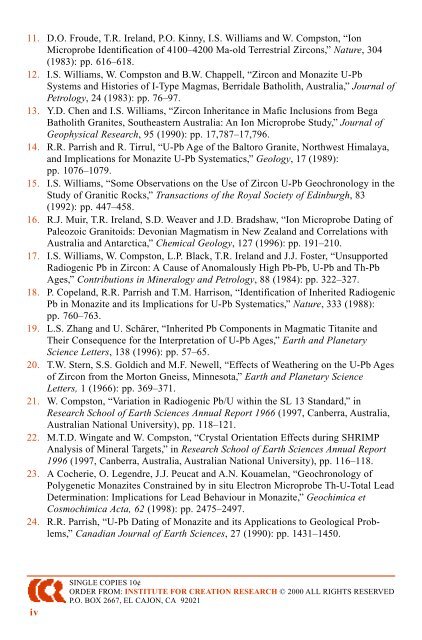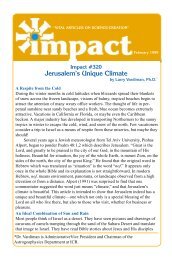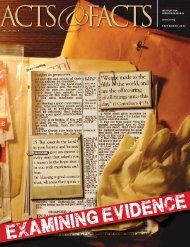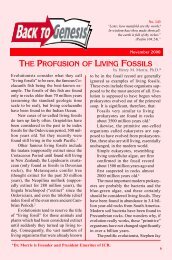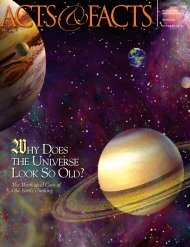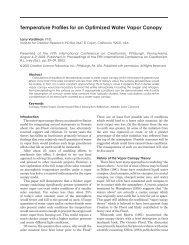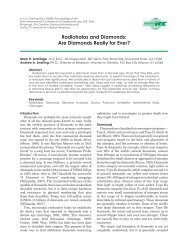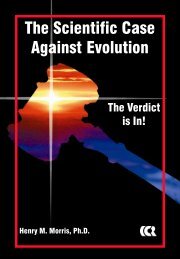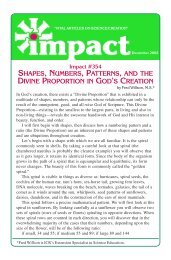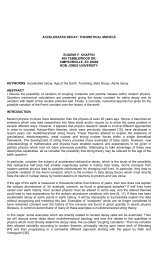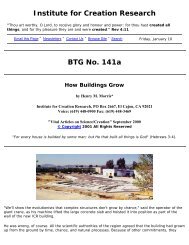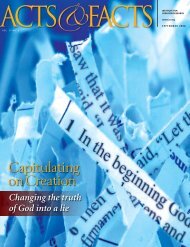U-Th-Pb MINERAL DATING IN DOUBT - Institute for Creation ...
U-Th-Pb MINERAL DATING IN DOUBT - Institute for Creation ...
U-Th-Pb MINERAL DATING IN DOUBT - Institute for Creation ...
You also want an ePaper? Increase the reach of your titles
YUMPU automatically turns print PDFs into web optimized ePapers that Google loves.
11. D.O. Froude, T.R. Ireland, P.O. Kinny, I.S. Williams and W. Compston, “IonMicroprobe Identification of 4100–4200 Ma-old Terrestrial Zircons,” Nature, 304(1983): pp. 616–618.12. I.S. Williams, W. Compston and B.W. Chappell, “Zircon and Monazite U-<strong>Pb</strong>Systems and Histories of I-Type Magmas, Berridale Batholith, Australia,” Journal ofPetrology, 24 (1983): pp. 76–97.13. Y.D. Chen and I.S. Williams, “Zircon Inheritance in Mafic Inclusions from BegaBatholith Granites, Southeastern Australia: An Ion Microprobe Study,” Journal ofGeophysical Research, 95 (1990): pp. 17,787–17,796.14. R.R. Parrish and R. Tirrul, “U-<strong>Pb</strong> Age of the Baltoro Granite, Northwest Himalaya,and Implications <strong>for</strong> Monazite U-<strong>Pb</strong> Systematics,” Geology, 17 (1989):pp. 1076–1079.15. I.S. Williams, “Some Observations on the Use of Zircon U-<strong>Pb</strong> Geochronology in theStudy of Granitic Rocks,” Transactions of the Royal Society of Edinburgh, 83(1992): pp. 447–458.16. R.J. Muir, T.R. Ireland, S.D. Weaver and J.D. Bradshaw, “Ion Microprobe Dating ofPaleozoic Granitoids: Devonian Magmatism in New Zealand and Correlations withAustralia and Antarctica,” Chemical Geology, 127 (1996): pp. 191–210.17. I.S. Williams, W. Compston, L.P. Black, T.R. Ireland and J.J. Foster, “UnsupportedRadiogenic <strong>Pb</strong> in Zircon: A Cause of Anomalously High <strong>Pb</strong>-<strong>Pb</strong>, U-<strong>Pb</strong> and <strong>Th</strong>-<strong>Pb</strong>Ages,” Contributions in Mineralogy and Petrology, 88 (1984): pp. 322–327.18. P. Copeland, R.R. Parrish and T.M. Harrison, “Identification of Inherited Radiogenic<strong>Pb</strong> in Monazite and its Implications <strong>for</strong> U-<strong>Pb</strong> Systematics,” Nature, 333 (1988):pp. 760–763.19. L.S. Zhang and U. Schärer, “Inherited <strong>Pb</strong> Components in Magmatic Titanite and<strong>Th</strong>eir Consequence <strong>for</strong> the Interpretation of U-<strong>Pb</strong> Ages,” Earth and PlanetaryScience Letters, 138 (1996): pp. 57–65.20. T.W. Stern, S.S. Goldich and M.F. Newell, “Effects of Weathering on the U-<strong>Pb</strong> Agesof Zircon from the Morton Gneiss, Minnesota,” Earth and Planetary ScienceLetters, 1 (1966): pp. 369–371.21. W. Compston, “Variation in Radiogenic <strong>Pb</strong>/U Within the SL 13 Standard,” inResearch School of Earth Sciences Annual Report 1966 (1997, Canberra, Australia,Australian National University), pp. 118–121.22. M.T.D. Wingate and W. Compston, “Crystal Orientation Effects during SHRIMPAnalysis of Mineral Targets,” in Research School of Earth Sciences Annual Report1996 (1997, Canberra, Australia, Australian National University), pp. 116–118.23. A Cocherie, O. Legendre, J.J. Peucat and A.N. Kouamelan, “Geochronology ofPolygenetic Monazites Constrained by in situ Electron Microprobe <strong>Th</strong>-U-Total LeadDetermination: Implications <strong>for</strong> Lead Behaviour in Monazite,” Geochimica etCosmochimica Acta, 62 (1998): pp. 2475–2497.24. R.R. Parrish, “U-<strong>Pb</strong> Dating of Monazite and its Applications to Geological Problems,”Canadian Journal of Earth Sciences, 27 (1990): pp. 1431–1450.ivS<strong>IN</strong>GLE COPIES 10¢ORDER FROM: <strong>IN</strong>STITUTE FOR CREATION RESEARCH © 2000 ALL RIGHTS RESERVEDP.O. BOX 2667, EL CAJON, CA 92021


